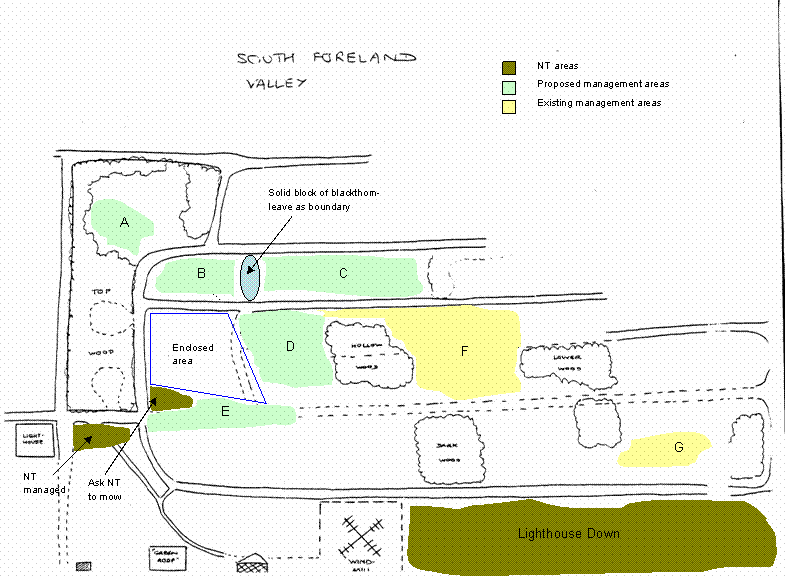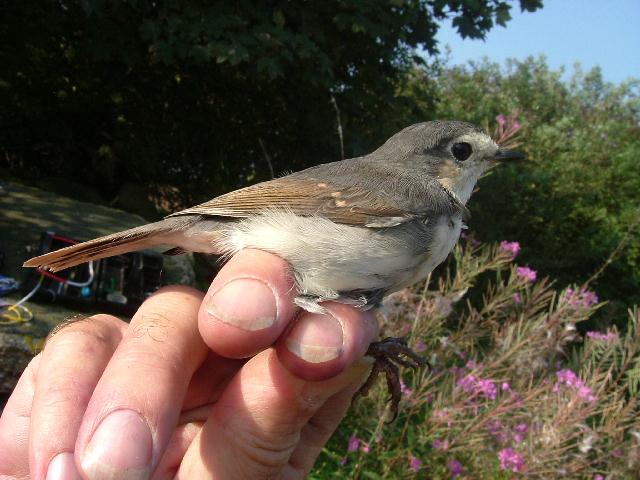FOREWOOD
The South Foreland Valley
Updated 6 November 2006 with details of 3 volunteer task days, and some Autumn photos
This page is for information about the South Foreland Valley in the village of St Margaret's-at-Cliffe near to Dover in Kent. Recent scrub clearance has drawn attention to the need for a re-evaluation of the management of this important local amenity which is owned by the Parish Council
The first draft management plan for the valley has been prepared and is about to be circulated to interested parties for comments - watch this page for more details. In the meantime, Richard Haynes at the White Cliffs Countryside Project has organised 3 volunteer task days for the Valley, all involving scrub clearance, as follows
Thursday 21st December 06 – Scrub clearing. Meet 10.15am entrance to the valley by
Wednesday 10th January 07 – As above.
Wednesday 7th March 07 – As above.
For more detailed information about birds in the Valley, click here
For a link to the White Cliffs Countryside Project, click here
There is much to preserve and enjoy in the Valley
There has been plenty of Autumn colour, too
A preliminary draft management statement has been drawn up by Ian Hodgson, a regular and expert birdwatching visitor to the Valley. It is hoped this will lead to the establishment of a long term management strategy following consultation with the Parish Council, parishioners, and users of the Valley. This initial statement, which is reproduced below, has now been submitted to the White Cliffs Countryside Project
The WCCP has a format for management plans, based on models from the Kent Wildlife Trust and English Nature, and will use the draft to draw up a proposal following this format. Anyone who wishes to comment on this draft, or who wants to be involved is invited to contact the White Cliffs Countryside Project. Richard Haynes at the WCCP is taking the lead on the South Foreland Valley and it's future management - contact him at
Richard HaynesProject Officer
White Cliffs Countryside Project
Countryside Management Centre
Cherry Garden Upper Works
Castle Hill
Folkestone
Kent CT19 4AJ
Telephone / fax 01303 274806
email -richardhaynes@whitecliffscountryside.org.uk
In addition to comments about the future management of the South Foreland Valley, there are a number of volunteering opportunities for the local community. Voluntary Wardens are wanted just to keep an eye on the site, checking and reporting-in on grazing stock, fencing, anti-social behavior and vandalism - as he can't be there all the time
There are going to be some Volunteer Task Events - starting on Sunday 4th June2006 - for plant monitoring and footpath clearance - meet at the Pines Garden at 10:20am. This is to be repeated on Tuesday 27th June - same time and place. They will be a good opportunity to meet Richard and get to know him, to volunteer as a Warden, and set up contacts
The WCCP is now working on the Management Plan, based on Ian's first draft, and a copy is hopefully going to be circulated in 2 or 3 months time - it will also I hope be posted at this site
This page has been made available by a St Margaret's resident and birdwatcher to help ensure full public access to the process and participation in the drafting of a new management plan
The following pictures are of the valley in April 2006
And finally, for comparison, a photo from more or less the same as this last one, but in 1985, both courtesy of Ian Hodgson
Some Thoughts on a Management Plan for the
South Foreland Valley March 2006
These proposals have deliberately been restricted to the top two thirds of the valley, from the area between the Lower and Hollow Woods to the boundaries of the Top Wood. As things stand, and in the light of past experience, this represents an area that might reasonably be expected to be managed using a combination of volunteer effort, grazing and the National Trust, should it prove possible to gain their involvement, together with a small amount of input from paid contractors.
If funding were to permit larger scale input from contractors, the lower part of the valley would benefit from inclusion in the plan, principally by implementing a programme of rigorous scrub control, augmented by grazing, between the Lower Wood and Pines Gardens .
Reference is made throughout to the White Cliffs Countryside Project (WCCP), the National Trust (NT) and the Royal Society for the Protection of Birds (RSPB).
An overview
Photographs of the valley taken in 1985 show discrete blocks of woodland (the Top, Hollow and Lower Woods on the attached map), surrounded by almost scrub-free chalk grassland. In the intervening years, scrub inundation has increased to the point that some areas of grassland have been completely lost, while others are seriously threatened. Proposed management is designed to reverse this trend, so that the value of remaining grassland parts of the site to plants and invertebrates will be retained.
Areas managed by the National Trust
NT owns and manages the triangular section on the sea side of the Top Wood, adjacent to the lighthouse. They should be encouraged to extend this management, which mainly involves mowing, to the section just beyond the cattle grid, bordering the enclosed area.
The enclosed area
This section was enclosed to prevent cattle grazing the area favoured by breeding Marsh Warblers. Although the warblers have since disappeared, due to the activity of egg thieves, it is strongly recommended that the enclosure be kept, for several reasons:
The possibility exists that Marsh Warblers may return to the area
- Chemicals can be used in this area since it will not be accessible to grazing animals. This might benefit attempts to control bracken and golden rod, both of which have proved to be antagonistic to the warblers’ preferred nesting habitat; rosebay and great willowherb.
- Bird ringing takes place within this area and is largely unused by the public, a situation that is preferable for the safety of birds and the public
- This area contains a block of cherry that should be removed. Efforts should be made to maximise the extent of willowherb within the fenced enclosure, possibly by pruning of large ashes and removal of sycamore and buddleia, particularly where they shade the open willowherb-dominated areas. It has been necessary to control bracken with chemicals in the past and this treatment may again prove necessary, though at present golden rod is proving particularly invasive. Continued RSPB involvement should be sought where necessary.
Proposed management areas (A – E on the attached map)
These areas have been identified as areas that would benefit from scrub control and/or clearance, augmented by a programme of grazing to check re-growth. The intensity of the approach will vary according to the current level of scrub inundation, the benefits to be gained for invertebrates by opening up the areas of grassland and the need to deter 4WD access, while allowing public access throughout.
Japanese knotweed and growth of saplings need control, though the bramble scrub acts as a useful breeding habitat for birds
- Some light scrub removal could be attempted on the area bordering the informal car park but this is currently not a high priority
- A high priority area that is still relatively open. It would benefit from scrub removal to maximise the extent of open chalk grassland on a south-facing slope. The block of blackthorn could be left as a deterrent to 4WD access, as should the boundaries with the adjacent roads. Within the area, removal of sycamore, blackthorn, hawthorn, privet and dogwood should take place, back to the blackthorn hedge bordering the upper road.
- Another high priority, relatively open area on a south-facing slope that would benefit from removal and control of emergent sycamore, holly, hawthorn, golden rod and dogwood. Attention should be given where necessary to the shading effect of trees on the sea side of this area and intrusion from this side and from the Hollow Wood, whose boundaries should be prevented from spreading.
- The grassy embankment bordering the track would benefit from removal of holly, sycamore, dogwood and hawthorn scrub, as would the border to the path on the inland side, as far as the seat that overlooks the valley.
Existing management areas (F and G on the attached map)
Control of scrub within the grazed area between the Hollow and Lower Woods (F) should continue, possibly with some more extensive removal on the upper bank near the drinking trough. Scrub regeneration in the cleared area adjacent to Lighthouse Down (G)
Should be monitored and further control implemented when necessary.

And finally, a puzzle - what's this bird? It was netted, ringed and released in September 2004 near to the Valley

You can see all the experts in the background frantically looking in their identification guides in order to identify it - there was every reason to hurry, for the bird's welfare came first, and it was released as quickly as possible. Thankfully digital cameras mean such uncommon birds can be ringed, photographed and released in seconds, thus ensuring they behave afterwards quite normally. If it were otherwise, then the valuable knowledge about bird movements and populations gained from bird ringing would be meaningless

It was a common Robin, by the way, with some sort of colour aberration!!
This Firecrest was trapped, ringed and released on 29 October 2006, typical of late Autumn migration through the valley
